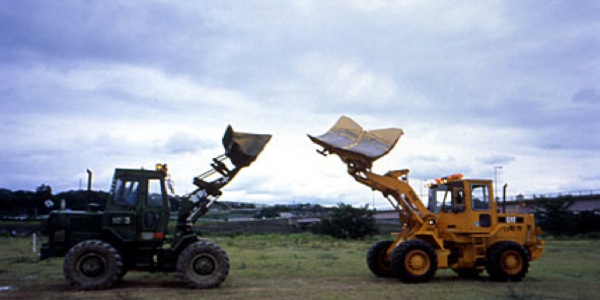
mierle
Mierle Ukeles: Garbage and Ritual
Mierle Laderman Ukeles has performed as an artist for 40 years, setting up her work as situations that show the overlooked civic sanitation worker. Ukeles spoke at the Santa Fe Art Institute May 10. The Denver-born New Yorker cited the freedom of her “kin,” 20th-century artists Pollock, Duchamp and Rothko, as inspiring her to become an artist. Ukeles, 71, said the “epiphany” of recognizing that motherhood was maintenance work stimulated her social art. In her 1969 Manifesto for Care she declared, “My working will be the work.”
Many artists have worked as museum guards. Ukeles, appropriating service roles in the early 70s, locked and unlocked doors at the Wadsworth Athaneum in Hartford, evoking territorial responses among the real guards charged with controlling access to the art. In 1974, she obsessively washed grime from the sidewalk in front of the A.I.R. Gallery on SoHos Wooster Street, a Sisyphean act destined for the storm sewer. Many artists were involved in making expressionist gestures on canvases, while her scrubbing the sidewalk into the gutter was physically comparable but emotionally worlds apart.
During the 60s and 70s other artists had made the city their medium: Gordon Matta-Clark explored the subterranean reaches of subway, tunnels and sewers. Trisha Brown performed semaphoric dances across the rooftops. Vito Acconci followed strangers through the streets surveilling them and himself.
All those things had to do with marking the city as territory. But what Ukeles undertook to do was explore one of the critical systems that made the city work – the sanitation department. Ukeles sought similar physical engagement to her fellow artist-mappers, but experienced the city as a social structure rather than as ground to be marked. Duchamp in 1917 remarked, “The only things America has given are her plumbing and her bridges.” Does Ukeless work affirm him?

Mierle Laderman Ukeles "Unburning Freedom Hall", Installation at Museum of Contemporary Art, Los Angeles, CA
In 1977 the New York City Sanitation Department invited Ukeles to be their first artist-in-residence (unpaid). She began a long-term project, Touch Sanitation, working with people, equipment, landfills and systems of refuse collection and disposal. She met and shook hands with each of 8500 sanitation workers, expressing words of gratitude, “Thank you for keeping New York City alive.”
She harbor-mastered a dance of garbage barges. She documented and diagrammed the routes and stations of the trucks. And she choreographed her own street dance to the motions of heaving a trash can.
If all this offal work makes you think taboo, Ukeles simultaneously used her art to explore the ritual mikva bath where menstruating women go, in her Jewish faith. She wrote an article describing that performance in the spring 1978 issue of the feminist journal Heresies. “It is my status as much as anyones that Im trying to free up,” Ukeles has said.
Ultimately Ukeless work aims to reverse the stigma on handlers of waste, that they are virtual untouchables. But where these shifts in perception come from has to be understood against the background of the modern city. Modernism conjoined hygiene in architecture and urban design with political egalitarianism. But the historical context that found Ukeles starting her work in this arena included the 1968 New York City sanitation strike, which Mayor John Lindsay called “the worst of my public life.” (From Wikipedia: “Quality of life in New York reached a nadir during the sanitation strike, as mounds of garbage caught fire and strong winds whirled the filth through the streets.”)
In 1989, Ukeles began working at the Fresh Kills landfill on the borough of Staten Island, with a reclamation project. Envisioning the future park of the 2200-acre site that had opened in 1948 and was, at its peak, the largest manmade structure on earth, Ukeles invited New Yorkers from across the five boroughs, to contribute palm-sized artworks. She mapped garbage zones that replicated the citys minutely detailed encodings of where the trash comes from. In doing so she turned urban planning into urban action and tapped a new network of art creators-cum-garbage producers whose small works will be assigned barcodes and encased in glass blocks to edge walking paths through the reclaimed landfill.
Unexpected after her years of working on this project, Fresh Kills was needed after the attacks on the World Trade Center and reopened two days after the 2001 catastrophe as ” a sorting ground” for the rubble and debris. Investigators spent 1.7 million hours poring through the wreckage searching for evidence, artifacts and human remains (300 bodies were identified there). The landfills southwest quadrant could be construed as cemetery and new ring of Dantes Hell.
In the Fresh Kills project Ukeless work has come full circle from locating the sanitation, firefighting and snow removal workers civic role in the framework of art, to re-assigning ritual art roles to those who created the garbage in the first place. As one walks the park along edged pathways, unseen but present will be tiny indicators of the population whose detritus underlies the landscape where theyre walking. “Im setting up a structure and having a lot of openings in the structure for other people to enter at will,” Ukeles has said.
Frank Lloyd Wright saw the house as a digestive system. Ukeles appears to be expanding Wrights perception to the urban scale, in reversing understanding of the landfill as a “taboo landscape” into a new stage for the enactment of public ritual. Cloaca maxima. Art is what remains.
